I’m going to take a quick break from discussing graded comics (CGC vs CBCS vs PGX) to take a moment to talk about…graded comics.
Compared to some, my book collection might be considered modest (around 5k+ books or so, last I bothered to keep track). Of these, only the tiniest fraction are slabbed books (predominately CGC with a few PGX). I have just enough to fill a single CGC box at the moment, with hopes of filling another. But every book so far has been purchased as an already slabbed item, I have never sent a book in to be graded…until now.
Early on I bought into the hype about CGC and how it was the only “reputable” place to send books off to be graded. While CGC is a fine company in my not-so-humble opinion, I came to realize that there is a fair bit of fanboy propaganda out there. Owning more than a few books graded by both CGC and the maligned competition, at the end of the day and for most purposes, there is no significant difference in the quality of grading and encapsulation. Any measurable differences lay in the details, dependent only upon the extra services desired.
For this reason, I had selected to send my books to PGX rather than the other alternatives. With general quality (again, grading and encapsulation) being the same as the others, PGX also offered other services I needed in a more streamlined fashion, and with a lesser impact to my wallet. All this said, here are the books I sent:
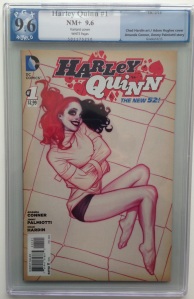
Harley Quinn #1 (2014): From the previous posts one might assume that I am a fan of Adam Hughes, and that would be absolutely correct. I purchased this book (a 1:25 variant) for two reasons, 1) the superb art by Mr. Hughes, of course, and 2) pure investment. HQ is a hot character for collection / investment purposes at the moment. I really don’t get it, myself…but whatever. What I did get is that this relaunch of a HQ main title was going to increase in value, quickly. An Adam Hughes cover was going to increase even more. What I did not expect is for it to sell for as much as $400 or more (for a 9.8 graded copy), at least not so early on in the series. But, here we are…and the copies are selling.
As a rule, I never grade a book higher than 9.6. As a conservative grader, I tend to “grade down” if there is any question. For this book, I picked it up “off the rack” for $15, and sat on it to send off for grading when the time was right. As a new book in “new” condition, I saw it as a 9.6 (Near Mint +), but secretly hoped it would return as one of the coveted 9.8’s floating out there. No such luck, I’m afraid. Even so, I saw a 9.6, and PGX saw the same thing, so I am pleased. The only downside to me is that a 9.6 seems to be going for about $260 as opposed to $400, last I looked. But no worries…it’s a fantastic book with exceptional work by Mr. Hughes, and I am very satisfied to have it slabbed and in my collection.
Saga #1 (2012): Here’s another book that was extremely hot. I recall reading the first few issues of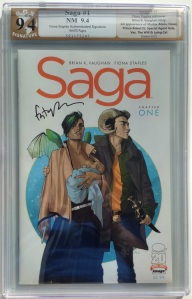 the series in the TPB, and it really wasn’t my thing. But the asking price for a copy of it was and is my thing. As I saw the values for this book continually rising, I finally knuckled under and bought a copy for just over $40. This was a year and a half ago, and now the going value is around $120, so not a bad investment, I would think (I hope my daughter one day appreciates all this nerdy “investing” I have done).
the series in the TPB, and it really wasn’t my thing. But the asking price for a copy of it was and is my thing. As I saw the values for this book continually rising, I finally knuckled under and bought a copy for just over $40. This was a year and a half ago, and now the going value is around $120, so not a bad investment, I would think (I hope my daughter one day appreciates all this nerdy “investing” I have done).
The real cool part is that I managed to get this book signed by Fiona Staples herself, along with issues three through eighteen (#2 was a CGC slabbed copy I had purchased, and I was reluctant to crack the case for a signature). She was at the LCS for signings, and I have to say that she was a very pleasant person indeed.
One of my concerns with autographed copies these days is that in the era of the CGC Signature Series, most signed books are suspect unless directly witnessed by an “authorized” representative of some sort. For CGC, this works out to benefit their little monopoly (which is shrinking by the day, thankfully – three cheers for marketplace competition!). In short, CGC essentially said that it did not recognize any signature unless they personally witnessed it. If they had not, any book graded by them would at best have a notation that names were signed on or in the book. Worse yet, it was possible for them to consider a signature as a defect, thus reducing the grade. Now, there are legitimate reasons for taking a protective stance like this, but what it did in terms of impact towards “non-verified” (by CGC, natch) books out there was a less than desirable shift in the minds of many collectors. I personally have a copy of New Teen Titans #1, signed by George Perez and Marv Wolfman, graded by CGC with the above mentioned notation. It does not mention the names that were signed, only that names were written in the book. I bought this book with four others, all signed by the same persons, the signatures having been collected by a single owner, all at the same time. After comparing pictures of the signatures with known authentic signatures of the contributors, I saw them as valid, and purchased the whole lot. Now I had entered the problem exacerbated (although I should again say that it is with some merit) by CGC, that the signatures would not be considered authentic, since they had not personally witnessed the signings. Not wanting to have books slabbed with a ratty little notation, what was I to do?
Enter PGX and CBCS. Both have a service dubbed “signature authentication”. This is different from a signature verification system wherein the books signature is personally witnessed. Instead, the signature(s) on the books goes through a process to determine if the signature is authentic, so a witness is not needed. This sort of minor science has been around for a long time, particularly with the policing agencies concerning themselves with fraud. Where a “verified” book is preferable, an “authenticated” book is the next best thing. This helps resolve any stigma associated with a signed book by providing an authoritative voice to say “it’s legit”.
Since this was my first submission to have books graded, I took advantage of the service, curious to see what came back. I knew that the signature was legitimate, since I got the book signed myself. I was pleased to see that the authenticator(s) agreed.
What pleased me even more about this book was that it came back with a grade of 9.4. I had thought this book to be Near Mint myself, but had some question, and as I mentioned, I grade down when in doubt.
New Teen Titans #2 (1980): This is one of the books I purchased in the lot mentioned above. Signed by George Perez (one of my favorite “old school” artists) and Marv Wolfman. Like I said, I was c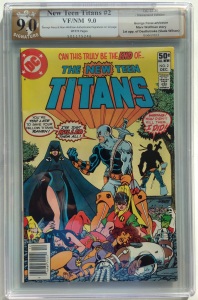 onfident that the signatures were valid, but here I am glad to see that those doing the authentication concur. Marvelous post-silver age book to have, the first appearance of Deathstroke. I remember when this came out. I was a Marvel guy at the time, having little to do with DC. This series changed that. I followed George to DC when he made the switch between companies, and jumped right on board with him on this series. It was a big deal for DC at the time.
onfident that the signatures were valid, but here I am glad to see that those doing the authentication concur. Marvelous post-silver age book to have, the first appearance of Deathstroke. I remember when this came out. I was a Marvel guy at the time, having little to do with DC. This series changed that. I followed George to DC when he made the switch between companies, and jumped right on board with him on this series. It was a big deal for DC at the time.
The downside of this for me was that it was graded a 9.0. I saw it as a 9.2, but given a certain amount of subjectivity that is inherent with grading, I was prepared to accept grades one up or down. Whereas I had expected Saga #1 to come back a 9.2 instead of the 9.4 it received, it follows that I accept the 9.0 for this one. Either way, for both I am pleased that they are graded well within what I had expected. And now I have two books graded and encapsulated with legit signatures. Woot!
Dejah of Mars #2 (2014): Part of my purpose with my first submission was to test out a few different services. With this one I wanted to give the pressing service a spin. Collectors know that restoration on a comic book has its ups and downs. While various forms of restoration can help preserve a book and generally make it more appealing to look at, it also tends to devalue the book itself. As a loose and general rule, I have adopted the simple view that a restored book is worth about half its apparent value. For instance, if a book were originally Fine (6.0) without restoration and with a value of $50, a restored book with an apparent condition of Very Fine (8.0) and a value of $90 at that grade would in fact be worth around $45, less than if it had been left unrestored. This is, of course, a simple example to make the point that restoration can actually devalue a book, and is generally looked down upon by the collecting community.
That aside, however, there are some forms of restoration that are considered legitimate, for which there is no penalty in terms of grading or appraisal. This is generally known as “pressing”, a minor form of restoration that does not add or detract anything from the book itself. Basically, this is a method of 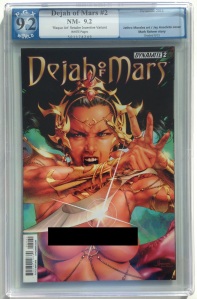 cleaning and pressing (hence the term) a book to remove light dirt and surface materials, as well as help correct some accumulated deficiencies in the books physical properties (bends, folds, rolls, wrinkles, etc.).
cleaning and pressing (hence the term) a book to remove light dirt and surface materials, as well as help correct some accumulated deficiencies in the books physical properties (bends, folds, rolls, wrinkles, etc.).
This book is what has come to be called a “risque” variant. Basically, it has a nude variant for cover art (which in this case is identical to the original print, sans clothing) and is geared more towards adult collectors. I have several of these in my collection, as they tend to be worth more money (harder to find, supply and demand rules the market). Not always, but often enough to take the gamble. The real attraction to me though is the cover art by Jay Anacleto. I only recently found out about this guy, but man am I glad I did. Some of his work is just incredible. One might think that there are two other reasons to be attracted to this cover, but believe me when I say that it is the face. The realism and passion with which he paints Dejah’s face is absolutely master class, if you ask me. For this reason I just had to get it slabbed.
The bummer about the copy I had was that on the back cover the book was wrinkled towards the spine, and significantly so. Other than this, the copy was in great shape with only a few stress lines here and there near the staples. I graded the book myself as an 8.0, given the substantial issue at hand. Were it not for that, it would have probably been a 9.2, possibly a 9.4.
So I sent it in to be pressed as part of the service. I had hoped for an 8.5, or possibly a 9.0. I was ecstatic when it came back a 9.2. Not believing the grade I was seeing, I took a look at the back cover and was seriously impressed with the work that had been done. Giving the book covers a complete scanning, I agreed with the grade completely. These guys took an 8.0 book and increased it three grades, all with permissible “restoration”. Although this book is the least valuable of the whole lot I sent in (at VF (8.0) it is valued at around $48, mid-fifties at 9.2, an admittedly minor increase), it is also the one I am most pleased with, simply to know what was done with it.
Conan the Barbarian #1 (1970): Like many, I am a returning collector, having sold my collecti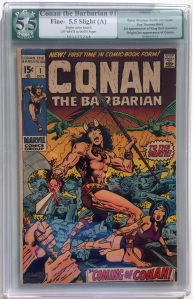 on when I was young and gotten back into the game years (decades) later. But as such, I knew that this was a book that I just had to have in my collection. I can be a frugal collector at times though (and indulgent at others), so I elected to pick up a lesser grade copy for what I thought was a bargain…just shy of a hundred bucks for what appeared to be a Fine copy. The book had a significant spine roll and quite a bit of cover dirt accumulated, but that aside I could not see it being less than a 6.0. So I sent it in to be pressed, which I had expected to be helpful in removing some of the cover grime. This submission was probably my biggest disappointment (although a credit to PGX, to be fair), given my surprise at how it returned to me.
on when I was young and gotten back into the game years (decades) later. But as such, I knew that this was a book that I just had to have in my collection. I can be a frugal collector at times though (and indulgent at others), so I elected to pick up a lesser grade copy for what I thought was a bargain…just shy of a hundred bucks for what appeared to be a Fine copy. The book had a significant spine roll and quite a bit of cover dirt accumulated, but that aside I could not see it being less than a 6.0. So I sent it in to be pressed, which I had expected to be helpful in removing some of the cover grime. This submission was probably my biggest disappointment (although a credit to PGX, to be fair), given my surprise at how it returned to me.
One of the things that the CGC cult like to point at as a feature that PGX supposedly lacks is the ability to detect restoration. The insinuation is that PGX is unreliable, and not to be taken seriously by serious collectors. As I’ve stated, I believe this is a lot of hot air generated by fanboys. Now I do, for some reason, still have the impression that CGC might have a more sophisticated detection suite, and perhaps a greater ability to detect more nuanced forms of restoration, but I do not know this to be the case as a matter of fact. The point is that I, as a consumer and an at least semi-serious collector am not interested in names (CGC, PGX, CBCS, or whatever), I am interested in quality at a reasonable cost (understanding that sometimes you get what you pay for). If I had a book that I had suspected of having been restored, to be honest, I would have sent it to CGC, if for no other reason than it is believed to have a more sophisticated means of restoration detection. I would not have selected PGX, not because it is necessarily inferior, but to make every effort to determine the condition definitively.
All that said, I was disappointed to find that this book came back as having minor restoration (slight color touch). Personally, I had not detected any. But then again, I am not a professional in the matter, and am only able to see more obvious attempts. But I also see this as a credit to PGX, who the cultists widely consider incapable in this regard. While my heart sank a bit initially, I am comforted to now know what I had not known before.
But another issue I had with how this book returned is that the pressing did not seem to do much to improve the condition of the book, not nearly as much as the Dejah of Mars book in any event. I have looked over it again several times, and if any improvements had been made, they are very minor at best. The spine is still “rolled” significantly, to the point where the staples appear to be about a quarter of an inch in on the front cover rather than squarely at the side of the book. I had hoped this would have been corrected. And the cover has a slightly dingy look to it even still, although it appears a little cleaner than what it was when sent. Where Dejah was a spectacular win, this book returned to me with less impressive but noticeable results.
The bummer is that it returned graded as a 5.5. To be honest, I still am not sure how it is less than a 6.0. Here’s the dollars and cents of how this one panned out for me: Paid $98 for a 6.0 book “guiding” at around $90 (I knowingly overpaid, expecting short term appreciation). It returned to me as a 5.5 ($70) restored, yielding an actual value of around $35. See how that works (according to my calculations, anyway)? Basically, compared to the actual value of the book, I now realize I overpaid somewhere in the neighborhood of 280%…ouch. Add to that the investment for pressing and grading (along with shipping and insurance), and this little book has been quite costly…but now I know what I actually have too, and so will any future purchaser (if there is one…I don’t really sell my books).
As for the grade, like I said, I was and am prepared to accept a grade plus or minus one from what I graded it. I am confident enough in my grading to know that if I am not right on, then I am in the very immediate neighborhood (unless restoration is involved). And again, some grading is subjective.
All in all, the experience I’ve had with this submission is quite satisfactory. Everything came back with grades reasonably comparable to what I had expected (having submitted books with grades ranging from Fine to Near Mint), so I am convinced that the company I selected is professional enough for any reasonable standards. I am particularly happy with the detection of restoration. The encapsulation is comparable to each of the other companies in every respect (although I wish PGX would adopt a more attractive and informative grading label, but that is more a cosmetic preference than anything else). The pressing service was serviceable yet less than impressive for the one book, but no less than spectacular for the other. The signature authentication correctly identified a valid signature I had obtained myself, and another couple which I had compared to originals before submitting.
The last thing I would mention has to do with simple dollars and cents. Being that I needed particular services that CGC does not provide (signature authentication and pressing), this left me with two options: CBCS or PGX. CBCS basically recommends, or “out-sources” these services to other companies with whom they appear to have established relationships. This certainly increases the turnaround time, since they have to go through these external processes before ever arriving at CBCS for evaluation. And, these services appear to be more costly as well, if done under the CBCS recommended scheme of things (not to imply they are “scheming”). In the end I found the same services to be less costly and having minimal impact on turnaround (around 5 weeks total, including shipping to and fro) with PGX. If the customer reviews are to be believed, it appears that CBCS has joined company with CGC in it’s inability to deliver on posted turnaround times, often by four, five, six or more months later than expected.
In truth, my initial plan was to send to CBCS. My rationale was that I had graded books by both of the others, that I liked what I was seeing in terms of appearance and reviews, and that it was cheaper than CGC (which has pummeled consumers with excessive costs for years – but that was the market then…hopefully they catch up). What killed this choice very early on was the outrageous shipping costs. I was initially quoted $30 for return shipping on a single book. When I asked for shipping quotes on 5 and 10 book submissions, I was given a very spartan response of $60, approximately (which I have to interpret as being low-balled). The communication appeared curt (although perhaps not intended that way), and failed to distinguish between whether this single figure applied to the five or ten book submission scenario. I had to assume that if they were going to charge me $30 for a single book, the $60 figure must apply to the five book proposition. PGX, on the other hand, charged me $38 for return shipping and insurance to the tune of about $1000, for the same five books submitted. I had considered CBCS as a kind of “middle-ground” in terms of pricing, until we started talking shipping, by which I was completely repulsed. Although, in fairness, I live in Canada, and CBCS ships from Florida. PGX, on the other hand, ships from Oregon. Even so…that’s a lot of dough for a few books. As a matter of fact, that thirty dollar or so difference is another two or three modern books I could have graded, rather than throw it away on extravagant shipping.
So there it is, my first submission experience in its near-entirety. I am sure I will be submitting to each of the companies in the future, based on different needs and situations. And although it could appear to some that I might prefer one over the other(s), I have no such partiality except where it concerns value for end product. In this matter, I am very much pleased thus far with the services rendered by PGX, and would recommend them for serious but more budget-conscious collectors.